Submitted:
08 May 2024
Posted:
08 May 2024
You are already at the latest version
Abstract
Keywords:
1. Introduction
2. Geological Setting
3. Methods
3.1. Drone Digital Elevation Models and Other Image Data
3.2. Offset Measurements of Landforms
3.3. Chronology Dating
4. Results
4.1. Distribution of the Study Site
4.2. The Southeast Segment
4.3. The Northwest Segment
4.4. Alluvial Fan Dating Results
5. Discussion
5.1. Geometric Distribution and Movement Characteristics
5.2. Estimating Slip Rate of the ALF
5.3. Differential Movement of the Block at the North Side of the Tian Shan
6. Conclusions
Author Contributions
Acknowledgments
Funding
Conflicts of Interest
References
- Molnar, P.; Tapponnier, P. Cenozoic tectonics of Asia: Effects of a continental collision: Features of recent continental tectonics in Asia can be interpreted as results of the India-Eurasia collision. Science 1975, 189, 419–426. [Google Scholar] [CrossRef] [PubMed]
- Tapponnier, P.; Molnar, P. Active faulting and Cenozoic tectonics of the Tien Shan, Mongolia, and Baykal regions. J. Geophys. Res. 1979, 84, 3245–3459. [Google Scholar] [CrossRef]
- Avouac, J.P.; Tapponnier, P.; Bai, M.; You, H.; Wang, G. Active thrusting and folding along the northern Tien Shan and Late Cenozoic rotation of the Tarim relative to Dzungaria and Kazakhstan. J. Geophys. Res.: Solid Earth 1993, 98, 6755–6804. [Google Scholar] [CrossRef]
- Bande, A.; Sobel, E.R.; Mikolaichuk, A.; Torres Acosta, V. Talas–Fergana Fault Cenozoic timing of deformation and its relation to Pamir indentation. Geological Society, London, Special Publications 2015, 427, 295–311. [Google Scholar] [CrossRef]
- Bosboom, R.; Dupont-Nivet, G.; Huang, W.; Yang, W.; Guo, Z. Oligocene clockwise rotations along the eastern Pamir: Tectonic and paleogeographic implications. Tectonics 2014, 33, 53–66. [Google Scholar] [CrossRef]
- Hendrix, M.S.; Dumitrn, T.A.; Graham, S.A. Late Oligocene-early Miocene unroofing in the Chinese Tian Shan: An early effect of the India-Asia collision. Geology 1994, 22, 487–490. [Google Scholar] [CrossRef]
- Burchfiel, B.C.; Brown, E.T.; Deng, Q.; Feng, X.; Li, J.; Molnar, P.; Shi, J.; Wu, Z.; Yu, H. Crustal Shortening on the Margins of the Tien Shan, Xinjiang, China. Int. Geol. Rev. 1999, 41, 665–700. [Google Scholar] [CrossRef]
- Deng, Q.; Feng, X.; Zhang, P.; Xu, X.; Peng, S.; Li, J. Active Tectonics of Tianshan; Seismological Press: Beijing, China, 2000. (In Chinese) [Google Scholar]
- Li, C.; Wang, S.; Li, Y.; Chen, Y.; Sinclair, H.; Wei, D.; Ma, D.; Lu, H.; Wang, X.; Wang, L. Growth of the Tian Shan Drives Migration of the Conglomerate-Sandstone Transition in the Southern Junggar Foreland Basin. Geophys. Res. Lett. 2022, 49. [Google Scholar] [CrossRef]
- Yang, X.; Li, Z.; Wang, W.; Zhang, P.; Wu, C.; Chen, G.; Duan, L.; Wu, X.; Liu, K. Quaternary Crustal Shortening of the Houyanshan Structure in the Eastern Chinese Tian Shan: Constrained from Geological and Geomorphological Analyses. Remote Sens. 2023, 15, 1603. [Google Scholar] [CrossRef]
- Li, J.; Yao, Y.; Li, R.; Yusan, S.; Li, G.; Freymueller, J.T.; Wang, Q. Present-Day Strike-Slip Faulting and Thrusting of the Kepingtage Fold-and-Thrust Belt in Southern Tianshan: Constraints From GPS Observations. Geophys. Res. Lett. 2022, 49. [Google Scholar] [CrossRef]
- Hu, Z.; Yang, X.; Li, A.; Yang, H.; Miao, S.; Yuan, H. Late Pleistocene slip rate and subsurface fault-plane geometry of the Latgan Fold (Bole Basin, North Tian Shan, NW China) derived from a deformed cosmogenically dated alluvial fan. Geomorphology 2023, 421. [Google Scholar] [CrossRef]
- Yin, A.; Nie, S.; Craig, P.; Harrison, T.; Ryerson, F.; Xianglin, Q.; Geng, Y. Late Cenozoic tectonic evolution of the southern Chinese Tian Shan. Tectonics 1998, 17, 1–27. [Google Scholar] [CrossRef]
- Thompson, S.C.; Weldon, R.J.; Rubin, C.M.; Abdrakhmatov, K.; Molnar, P.; Berger, G.W. Late Quaternary slip rates across the central Tien Shan, Kyrgyzstan, central Asia. J. Geophys. Res.: Solid Earth 2002, 107. [Google Scholar] [CrossRef]
- Peng, Z.; Graveleau, F.; Vendeville, B.C.; Wang, X.; Averbuch, O. Interaction between basement inherited strike-slip structures and thrust wedge propagation in the northern Tianshan foreland basin: Insight from analogue modelling experiments. J. Struct. Geol. 2024, 183. [Google Scholar] [CrossRef]
- Selander, J.; Oskin, M.; Ormukov, C.; Abdrakhmatov, K. Inherited strike-slip faults as an origin for basement-cored uplifts: Example of the Kungey and Zailiskey ranges, northern Tian Shan. Tectonics 2012, 31. [Google Scholar] [CrossRef]
- Yu, J.; Walker, R.T.; Rhodes, E.J.; Zhang, P.; Li, C.; Wang, S.; Wang, Y.; Liu, F.; Hao, Y. East Tacheng (Qoqek) Fault Zone: Late Quaternary Tectonics and Slip Rate of a Left-Lateral Strike-Slip Fault Zone North of the Tian Shan. Tectonics 2021, 40. [Google Scholar] [CrossRef]
- Burtman, V.S.; Skobelev, S.F.; Molnar, P. Late Cenozoic slip on the Talas-Ferghana fault, the Tien Shan, central Asia. Geol. Soc. Am. Bull. 1996, 108, 1004–1021. [Google Scholar] [CrossRef]
- Campbell, G.; Walker, R.; Abdrakhmatov, K.; Schwenninger, J.; Jackson, J.; Elliott, J.; Copley, A. The Dzhungarian fault: Late Quaternary tectonics and slip rate of a major right-lateraldextral strike-slip fault in the northern Tien Shan region. J. Geophys. Res.: Solid Earth 2013, 118, 5681–5698. [Google Scholar] [CrossRef]
- Hu, Z.; Yang, X.; Yang, H.; Huang, W.; Wu, G.; Miao, S.; Zhang, L. Slip rate and paleoseismology of the Bolokenu-Aqikekuduk (Dzhungarian) right-lateral strike-slip fault in the northern Tian Shan, NW China. Tectonics 2021, 40. [Google Scholar] [CrossRef]
- Abdrakhmatov, K.Y.; Aldazhanov, S.A.; Hager, B.H.; Hamburger, M.W.; Herring, T.A.; Kalabaev, K.B. Relatively recent construction of the Tien Shan inferred from GPS measurements of present-day crustal deformation rates. Nature 1996, 384, 450–453. [Google Scholar] [CrossRef]
- Zubovich, A.V.; Wang, X.; Scherba, Y.G.; Schelochkov, G.G.; Reilinger, R.; Reigber, C.; Mosienko, O.I.; Molnar, P.; Michajljow, W.; Makarov, V.I.; Li, J.; Kuzikov, S.I.; Herring, T.A.; Hamburger, M.W.; Hager, B.H.; Dang, Y.; Bragin, V.D.; Beisenbaev, R.T. GPS velocity field for the Tien Shan and surrounding regions. Tectonics 2010, 29. [Google Scholar] [CrossRef]
- Wang, M.; Shen, Z.K. Present-Day Crustal Deformation of Continental China Derived From GPS and Its Tectonic Implications. J. Geophys. Res.: Solid Earth 2020, 125. [CrossRef]
- Wu, C.; Zhang, P.; Zhang, Z.; Zheng, W.; Xu, B.; Wang, W.; Yu, Z.; Dai, X.; Zhang, B.; Zhang, K. Slip partitioning and crustal deformation patterns in the Tianshan orogenic belt derived from GPS measurements and their tectonic implications. Earth-Sci. Rev. 2023, 238. [CrossRef]
- Tsai, C.H.; Abdrakhmatov, K.; Mukambayev, A.; Elliott, A.J.; Elliott, J.R.; Grützner, C.; Rhodes, E.J.; Ivester, A.H.; Walker, R.T.; Wilkinson, R. Probing the Upper End of Intracontinental Earthquake Magnitude: A Prehistoric Example From the Dzhungarian and Lepsy Faults of Kazakhstan. Tectonics 2022, 41. [CrossRef]
- Li, A.; Ran, Y.; Gomez, F.; Thompson Jobe, J.A.; Liu, H.; Xu, L. Segmentation of the Kepingtage thrust fault based on paleoearthquake ruptures, southwestern Tianshan, China. Natural Hazards 2020, 103, 1385–1406. [Google Scholar] [CrossRef]
- Rizza, M.; Abdrakhmatov, K.; Walker, R.; Braucher, R.; Guillou, V.; Carr, A.S.; Campbell, G.; McKenzie, D.; Jackson, J.; Aumaître, G.; Bourlès, D.L.; Keddadouche, K. Rate of Slip From Multiple Quaternary Dating Methods and Paleoseismic Investigations Along the Talas-Fergana Fault: Tectonic Implications for the Tien Shan Range. Tectonics 2019, 38, 2477–2505. [Google Scholar] [CrossRef]
- Wu, C.; Wang, W.; Zheng, W.; Zhang, P.; Yu, Z. Opposite Sense of Strike-Slip Faulting and Crustal Rotation Accommodating Left-Lateral Shear Between the Tianshan Mountains and Kazakh Platform. Geophys. Res. Lett. 2021, 48. [CrossRef]
- Shen, J.; Wang, Y.; Li, Y. Characteristics of the Late Quaternary right-lateral strike-slip movement of Bolokenu-Aqikekuduk fault in northern Tianshan Mountains, NW China. Geosci. Front. 2021, 2, 519–527. [Google Scholar] [CrossRef]
- Tsai, C.H.; Walker, R.; Daout, S.; Abdrakhmatov, K.; Mukambayev, A.; Grützner, C.; Rhodes, E. Palaeo-earthquake magnitudes on the Dzhungarian fault, N. Tien shan, and implications for the rupture processes of intraplate strike-slip faults. In Proceedings of EGU2020: Sharing Geoscience Online, 4-8 May 2020. [Google Scholar] [CrossRef]
- Samygin, S. G. Chingiz wrench fault and its role in the structure of central Kazakhstan. Nauka Publishing House:Moscow, Russia, 1974. (In Russian).
- Mukambayev, А.S.; Mikhailova, N.N. Seismic hazard of the main Chingiz fault for the territory of Semipalatinsk test site. NNC RK Bulletin 2015, 3, 82–86, (In Russian with English Abstract). [Google Scholar]
- Li, Y.; Liu, M.; Hao, M.; Zhu, L.; Cui, D.; Wang, Q. Active crustal deformation in the Tian Shan region, central Asia. Tectonophysics 2021, 811. [Google Scholar] [CrossRef]
- Xu, X.; Han, Z.; Yang, X.; Zhang, S.; Yu, G.; Zhou, B.; Li, F.; Ma, B.; Chen, G.; Ran, Y. Seimotectonic Map of China and Its Adjacent Regions; Seismological Publishing Press: Beijing, China, 2016. (In Chinese) [Google Scholar]
- Xiao, W.; Han, C.; Yuan, C.; Sun, M.; Lin, S.; Chen, H.; Li, Z.; Li, J.; Sun, S. Middle Cambrian to Permian subduction-related accretionary orogenesis of Northern Xinjiang, NW China: Implications for the tectonic evolution of central Asia. J. Asian Earth Sci. 2008, 32, 102-117. [CrossRef]
- Xiao, W.; Santosh, M. The western Central Asian Orogenic Belt: A window to accretionary orogenesis and continental growth. Gondwana Res. 2014, 25, 1429–1444. [Google Scholar] [CrossRef]
- Wang, Y.; Wang, Y.; Yin, J.; Thomson, S.N.; Xiao, W.; He, Z.; Chen, W.; Cai, K.; Wu, M.; Meng, Y. Mesozoic exhumation of the northern West Junggar, NW China: Insights from low-temperature thermochronometers. Tectonophysics 2023, 862. [Google Scholar] [CrossRef]
- Buckman, S.; Aitchison, J. C. Tectonic evolution of Palaeozoic terranes in west Junggar, Xinjiang, NW China. Geological Society, London, Special Publications 2004, 226, 101–129. [Google Scholar] [CrossRef]
- Choulet, F.; Faure, M.; Cluzel, D.; Chen, Y.; Lin, W.; Wang, B. From oblique accretion to transpression in the evolution of the Altaid collage: New insights from West Junggar, northwestern China. Gondwana Res. 2012, 21, 530–547. [Google Scholar] [CrossRef]
- Wu, C.; Hong, T.; Xu, X.; Wang, C.; Dong, L. A-type granites induced by a breaking-off and delamination of the subducted Junggar oceanic plate, West Junggar, Northwest China. China Geology 2022, 4, 1-18. [CrossRef]
- Chen, B.; Jahn, B. Genesis of post-collisional granitoids and basement nature of the Junggar Terrane, NW China: Nd-Sr isotope and trace element evidence. J. Asian Earth Sci. 2004, 23, 691–703. [Google Scholar] [CrossRef]
- Zhu, Y.; Chen, B.; Xu, X.; Qiu, T.; An, F. A new geological map of the West Junggar, north Xinjiang (NW China): Implications for Paleoenvironmental reconstruction. Episodes, 2013, 36, 205–220. [Google Scholar] [CrossRef] [PubMed]
- Zheng, B.; Han, B.F.; Wang, Z.Z.; Liu, B.; Feng, L.X. An example of Phanerozoic continental crustal growth: The West Junggar Orogenic Belt, Northwest China. Lithos 2020, 376–377. [Google Scholar] [CrossRef]
- Hu, a.; Wang, Z.; Xu, G. Geologic evolution, petrogenesis and metallgenesis in northern XinJiang; Science Press: BeiJing, China, 1997; pp. 9–104. (In Chinese) [Google Scholar]
- Chen, Y.; Hu, a.; Zhang, G.; Zhang, Q. Zircon U-Pb age and Sr-Nd isotopic composition of granitic genesis and its geological implications from Percambrian window of western Tianshan, NW China. Geochimica 1999, 28, 515–519, (In Chinese with English Abstract). [Google Scholar]
- Chen, J.; Zhou, T.; Xie, Z.; Zhang, X.; Guo, X. Formation of positive ƐNd(T) granitoids from the Alataw Mountains, Xinjiang, China, by mixing and fractional crystallization: implication for Phanerozoic crustal growth. Tectonophysics 2000, 328, 53–67. [Google Scholar] [CrossRef]
- Yin, J.; Wang, Y.; Hodges, K.V.; Xiao, W.; Thomson, S.N.; Chen, W.; Yuan, C.; Sun, M.; Cai, K.; Sun, J. Episodic Long-Term Exhumation of the Tianshan Orogenic Belt: New Insights From Multiple Low-Temperature Thermochronometers. Tectonics 2023, 42. [Google Scholar] [CrossRef]
- Arrowsmith, J.R.; Zielke, O. Tectonic geomorphology of the San Andreas Fault zone from high resolution topography: An example from the Cholame segment. Geomorphology 2009, 113, 70–81. [Google Scholar] [CrossRef]
- Zielke, O.; Arrowsmith, J.R.; Grant Ludwig, L.; Akciz, S.O. High-Resolution Topography-Derived Offsets along the 1857 Fort Tejon Earthquake Rupture Trace, San Andreas Fault. Bull. Seismol. Soc. Am. 2012, 102, 1135–1154. [Google Scholar] [CrossRef]
- Bahrami, S.; Stokes, M. Analyzing drainage basin orientation and its relationship to active fold growth (Handun anticline, Zagros, Iran). Geomorphology 2023, 426. [Google Scholar] [CrossRef]
- Bi, H.; Zheng, W.; Ren, Z.; Zeng, J.; Yu, J. Using an unmanned aerial vehicle for topography mapping of the fault zone based on structure from motion photogrammetry. International Journal of Remote Sensing 2017, 38, 2495–2510. [Google Scholar] [CrossRef]
- James, M.R.; Robson, S. Straightforward reconstruction of 3D surfaces and topography with a camera: Accuracy and geoscience application. J. Geophys. Res.: Earth Surf. 2012, 117. [CrossRef]
- Johnson, K.; Nissen, E.; Saripalli, S.; Arrowsmith, J.R.; McGarey, P.; Scharer, K.; Williams, P.; Blisniuk, K. Rapid mapping of ultrafine fault zone topography with structure from motion. Geosphere 2014, 10, 969–986. [Google Scholar] [CrossRef]
- Kovanič, Ľ.; Štroner, M.; Blistan, P.; Urban, R.; Boczek, R. Combined ground-based and UAS SfM-MVS approach for determination of geometric parameters of the large-scale industrial facility – Case study. Measurement 2023, 216. [Google Scholar] [CrossRef]
- Bemis, S.P.; Micklethwaite, S.; Turner, D.; James, M.R.; Akciz, S.; Thiele, S.T.; Bangash, H.A. Ground-based and UAV-Based photogrammetry: A multi-scale, high-resolution mapping tool for structural geology and paleoseismology. J. Struct. Geol. 2014, 69, 163–178. [Google Scholar] [CrossRef]
- McCalpin, J. Paleoseismology Second Ed.; Academic Press 1996, San Diego, California.
- Zielke, O.; Klinger, Y.; Arrowsmith, J.R. Fault slip and earthquake recurrence along strike-slip faults—Contributions of high-resolution geomorphic data. Tectonophysics 2015, 638, 43–62. [Google Scholar] [CrossRef]
- Scharer, K.M.; Salisbury, J.B.; Arrowsmith, J.R.; Rockwell, T.K. Southern San Andreas Fault Evaluation Field Activity: Approaches to Measuring Small Geomorphic Offsets—Challenges and Recommendations for Active Fault Studies. Seismological Research Letters 2014, 85, 68–76. [Google Scholar] [CrossRef]
- Bi, H.; Zheng, W.; Lei, Q.; Zeng, J.; Zhang, P.; Chen, G. Surface Slip Distribution Along the West Helanshan Fault, Northern China, and Its Implications for Fault Behavior. J. Geophys. Res.: Solid Earth 2020, 125. [CrossRef]
- Sieh, K. E. Slip along the San Andreas fault associated with the great 1857 earthquake. Bull. Seismol. Soc. Am. 1978, 68, 1421–1448. [Google Scholar]
- Zielke, O.; Arrowsmith, J.R.; Ludwig, L.G. Slip in the 1857 and earlier large earthquakes along the Carrizo Plain, San Andreas Fault. Science 2010, 327, 1119–1122. [Google Scholar] [CrossRef] [PubMed]
- Wang, X.; Lu, Y.; Zhao, H. On the performances of the single-aliquot regenerative-dose (SAR) protocol for Chinese loess: fine quartz and polymineral grains. Radiat. Meas. 2006, 41, 1–8. [Google Scholar] [CrossRef]
- Murray, A.S.; Wintle, A.G. Luminescence dating of quartz using an improved single-aliquot regenerative-dose protocol. Radiat. Meas. 2000, 32, 57–73. [Google Scholar] [CrossRef]
- Wintle, A.G.; Murray, A.S. A review of quartz optically stimulated luminescence characteristics and their relevance in single-aliquot regeneration dating protocols. Radiat. Meas. 2006, 41, 369–391. [Google Scholar] [CrossRef]
- Aitken, M.J. An Introduction to Optical Dating; Oxford University Press: Oxford, Britain, 1998. [Google Scholar]
- Lu, Y.; Wang, X.; Wintle, A.G. A new OSL chronology for dust accumulation in the last 130,000 yr for the Chinese Loess Plateau. Quat. Res. 2007, 67, 152–160. [Google Scholar] [CrossRef]
- Murray, A.S.; Wintle, A.G. The single aliquot regenerative dose protocol: potential for improvements in reliability. Radiat. Meas. 2003, 37, 377–38. [Google Scholar] [CrossRef]
- Prescott, J.R.; Hutton, J.T. Cosmic ray contributions to dose rates for luminescence and ESR dating: Large depths and long-term time variations. Radiat. Meas. 1994, 23, 497–500. [Google Scholar] [CrossRef]
- Yuan, H.; Li, A.; Huang, W.; HU, Z.; Zuo, Y.; Yang, X. Geological deformation of the TuoLi fault in the west Junggar since the late Quaternary. Seismology and Geology 2023, 45, 49–66, (In Chinese with English Abstract). [Google Scholar]
- Wu, C.; Wang, W.; Zheng, W.; Zhang, P.; Yu, Z. Opposite sense of strike-slip faulting and crustal rotation accommodating left-lateral shear between the Tianshan mountains and Kazakh platform. Geophys. Res. Lett. 2021, 48, 1–8. [Google Scholar] [CrossRef]
- Campbell, G.E.; Walker, R.T.; Abdrakhmatov, K.; Jackson, J.; Elliott, J.R.; Mackenzie, D.; Middleton, T.; Schwenninger, J.L. Great earthquakes in low strain rate continental interiors: An example from SE Kazakhstan. J. Geophys. Res.: Solid Earth 2015, 120, 5507–5534. [Google Scholar] [CrossRef]
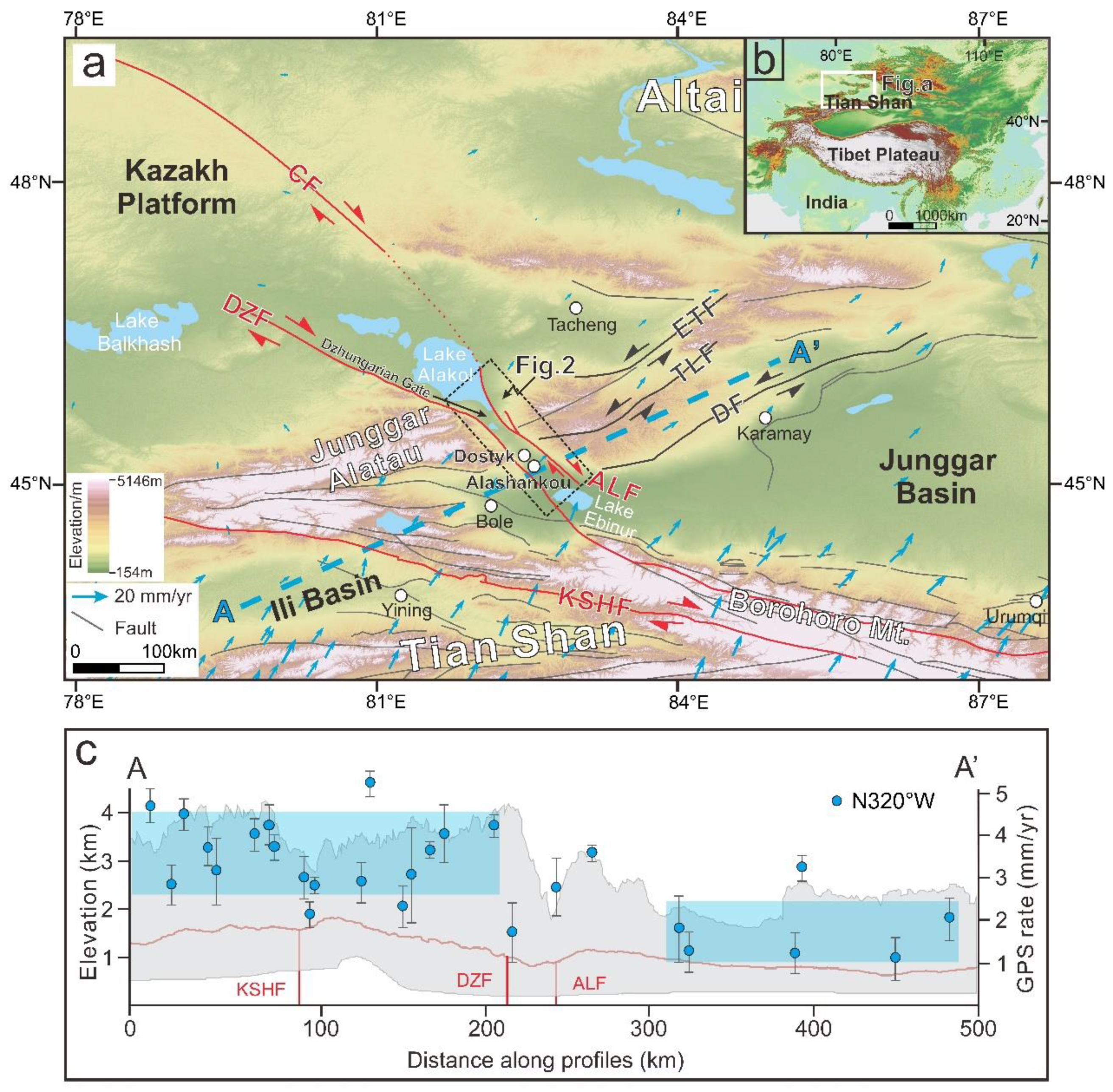
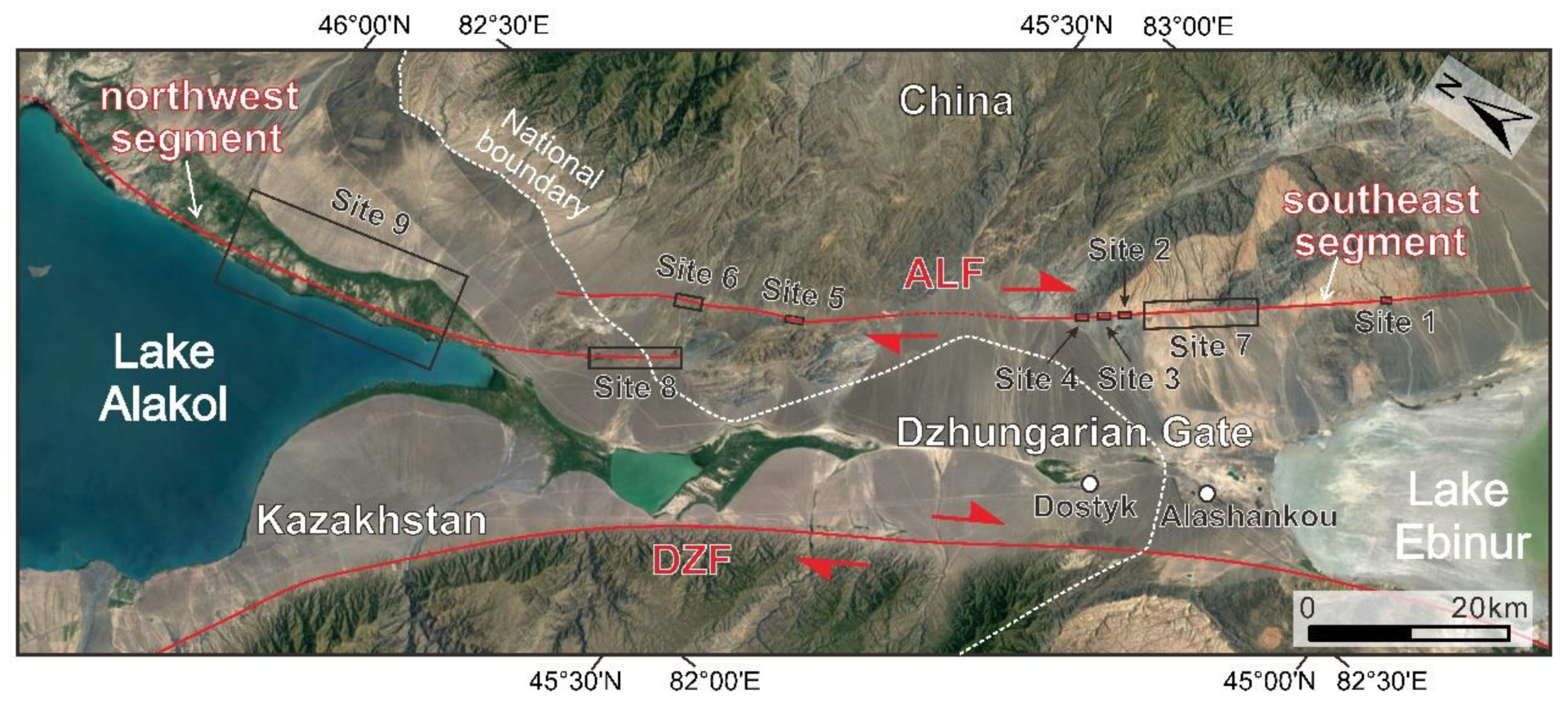
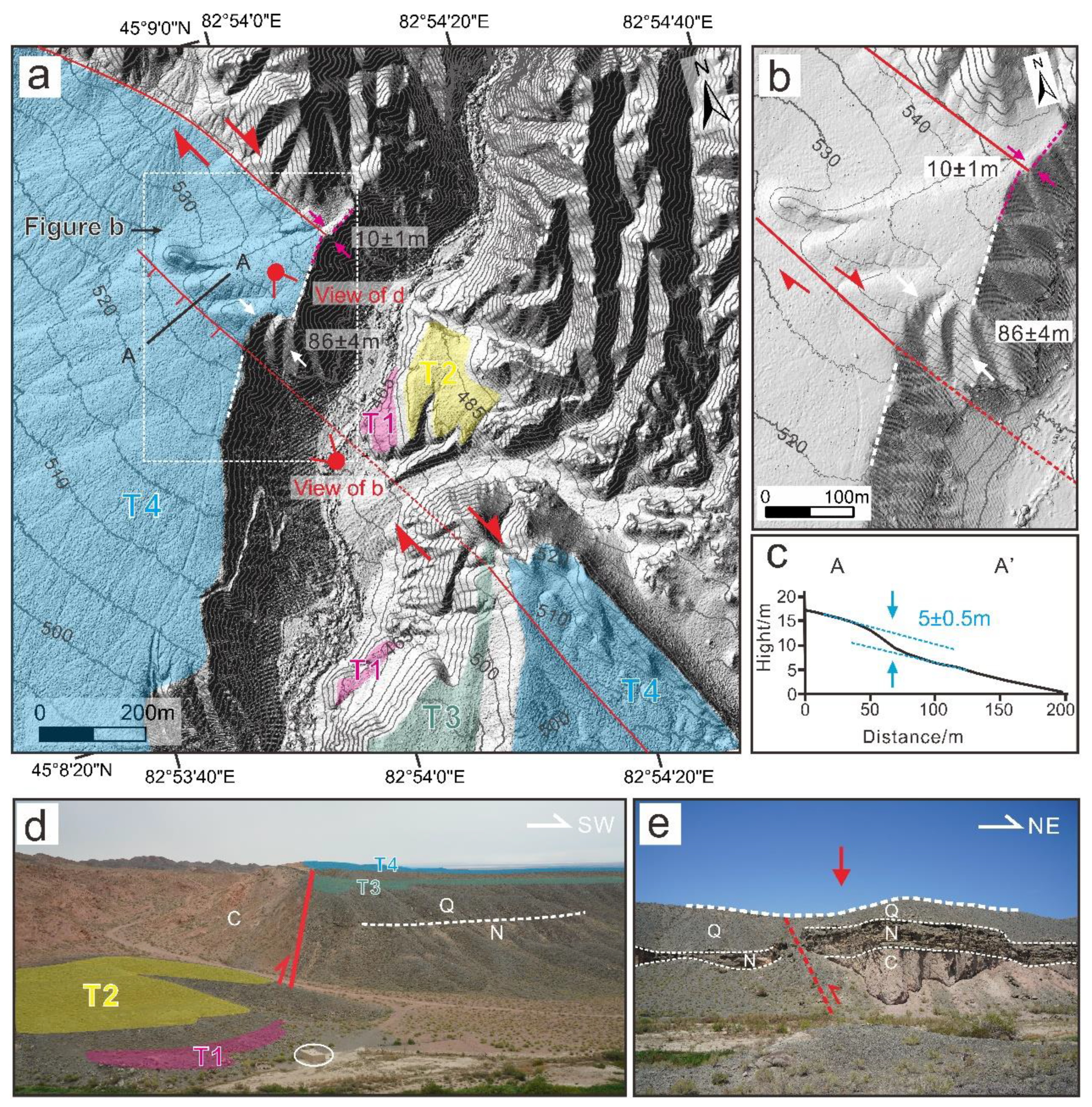
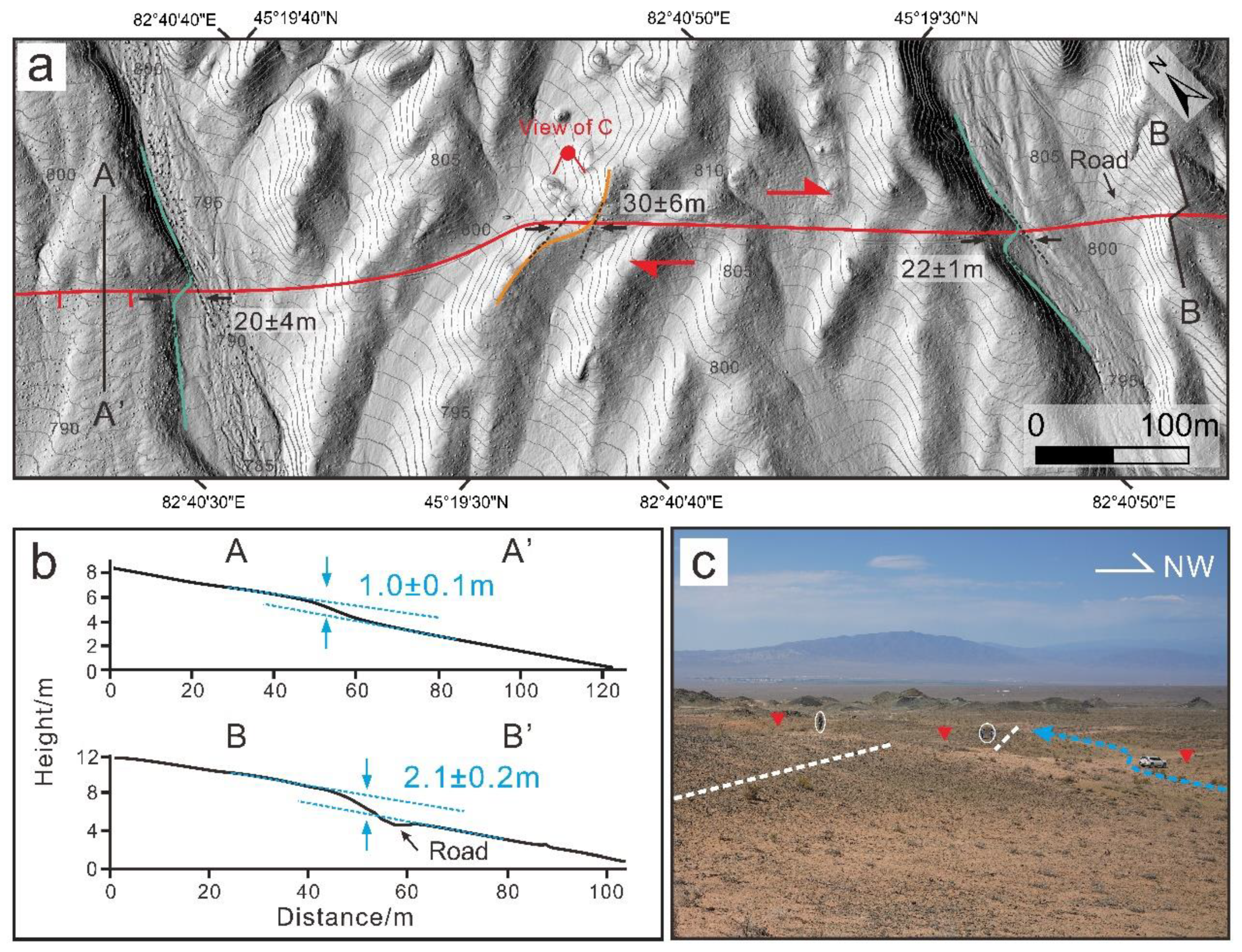
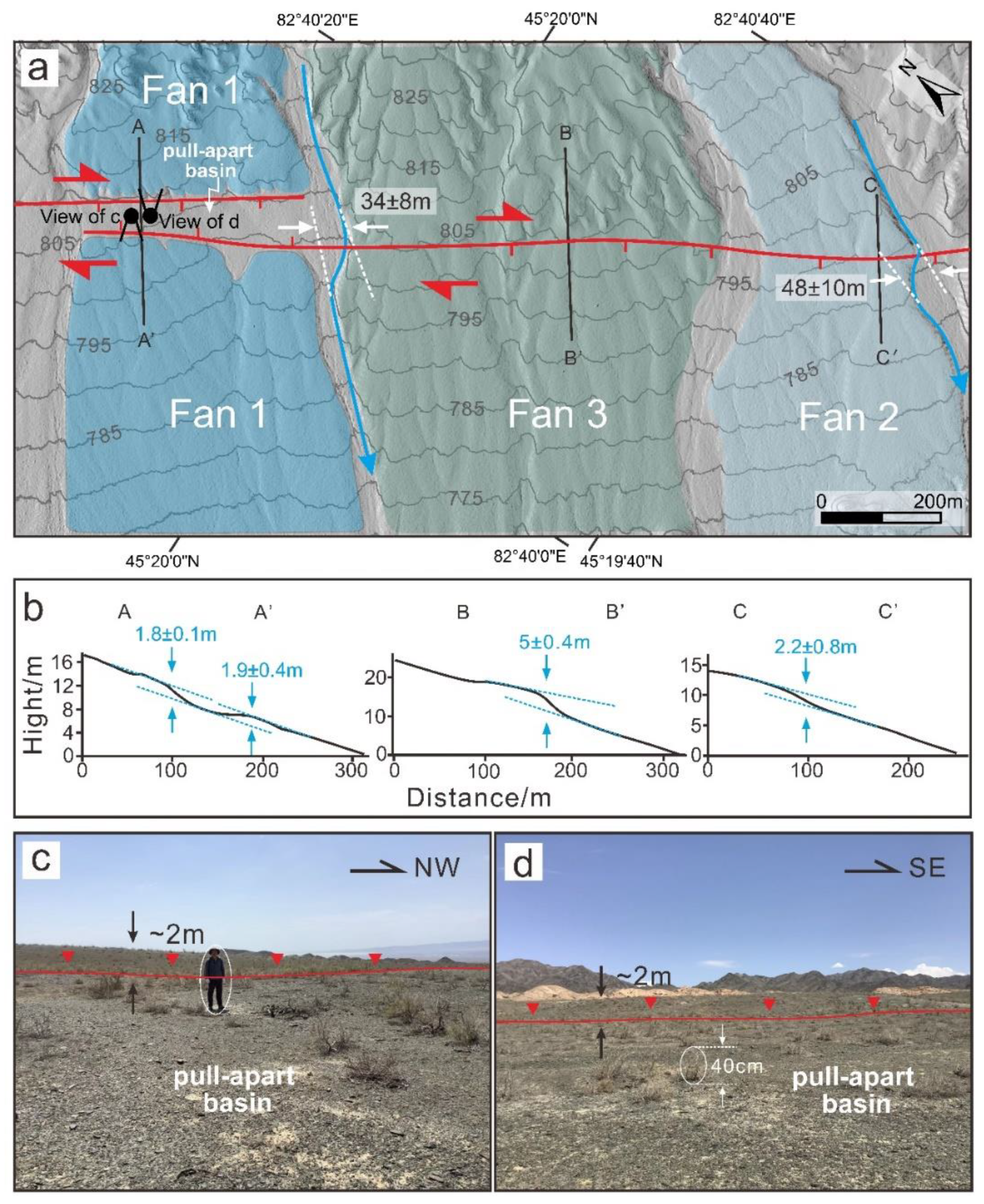
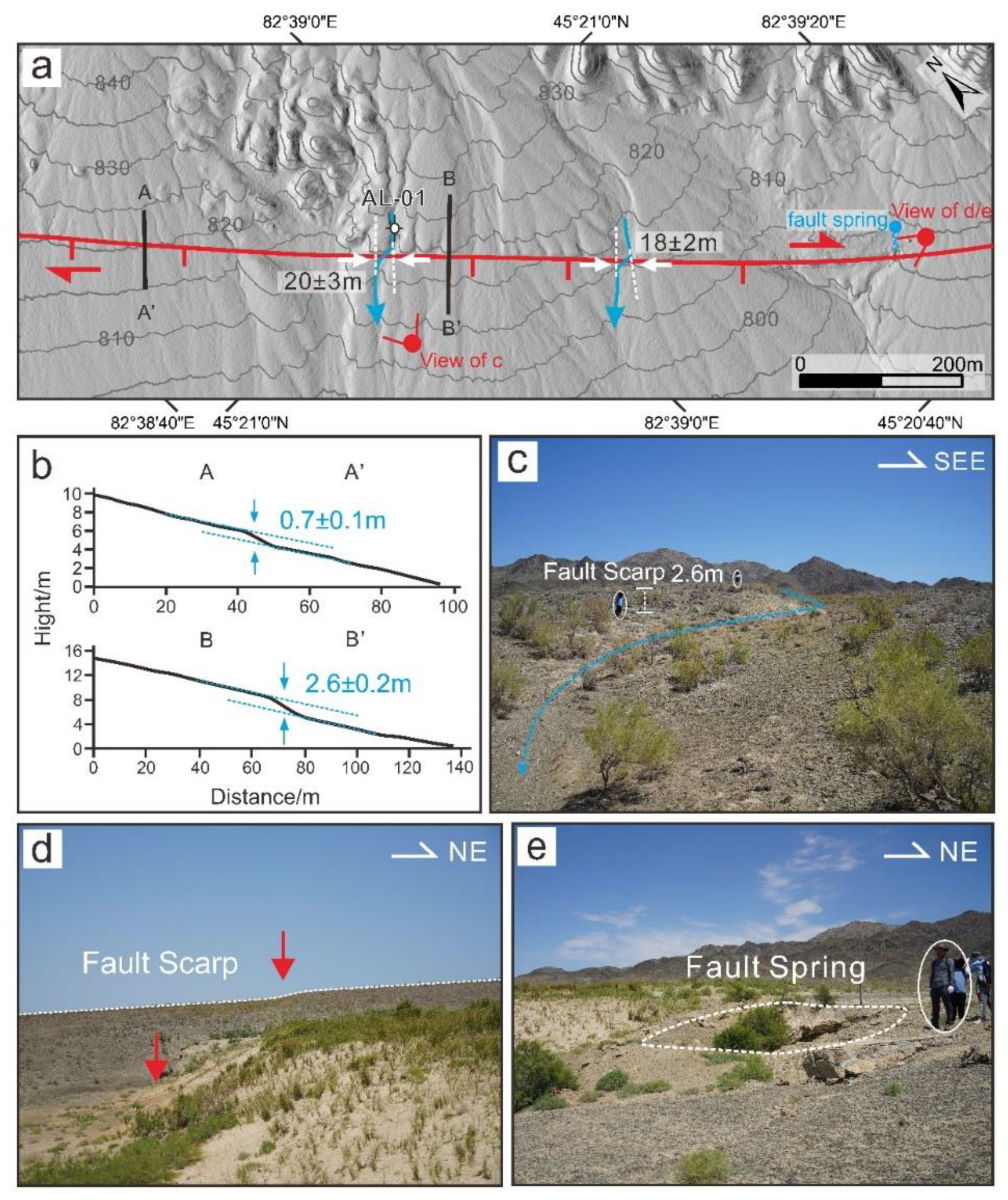
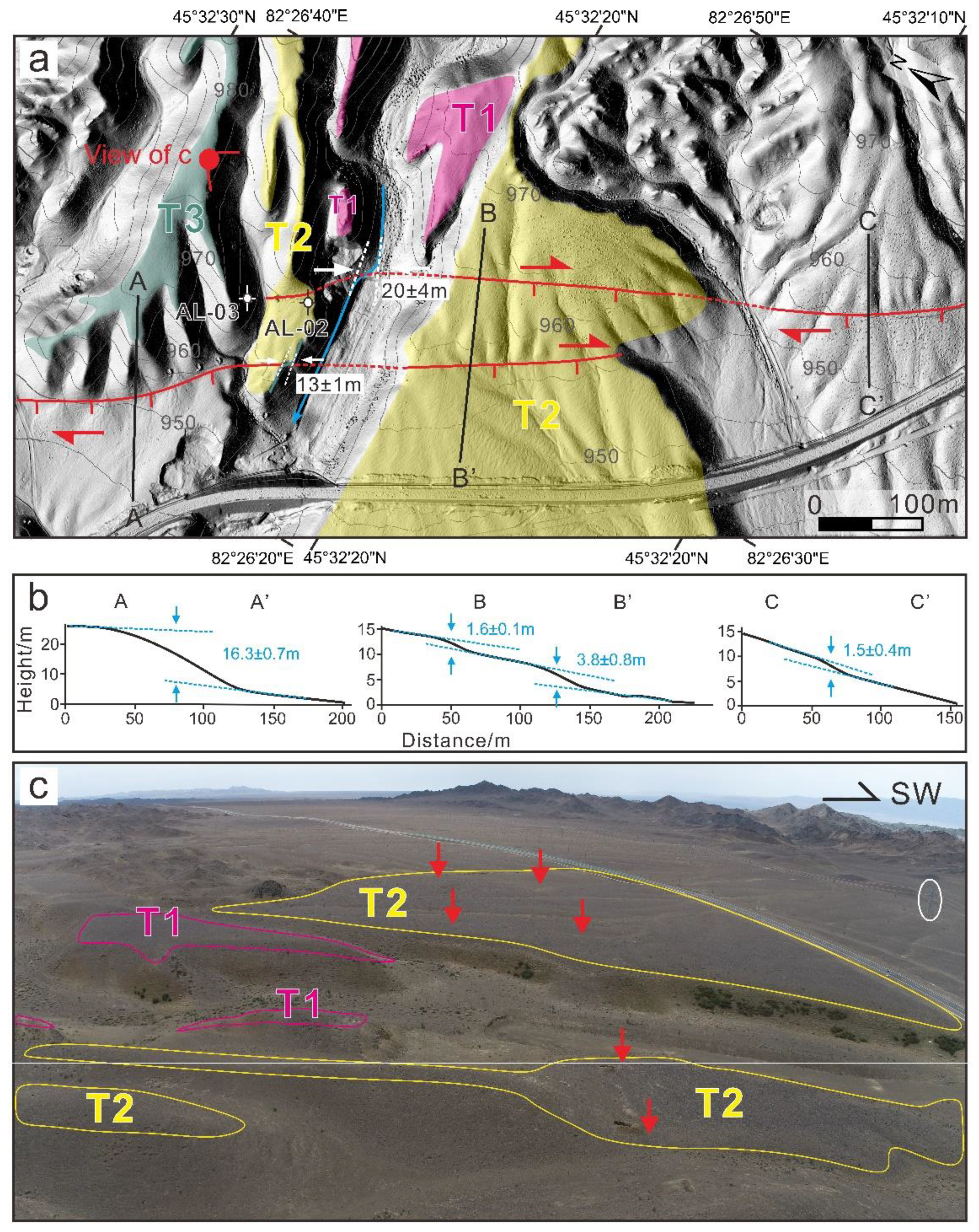
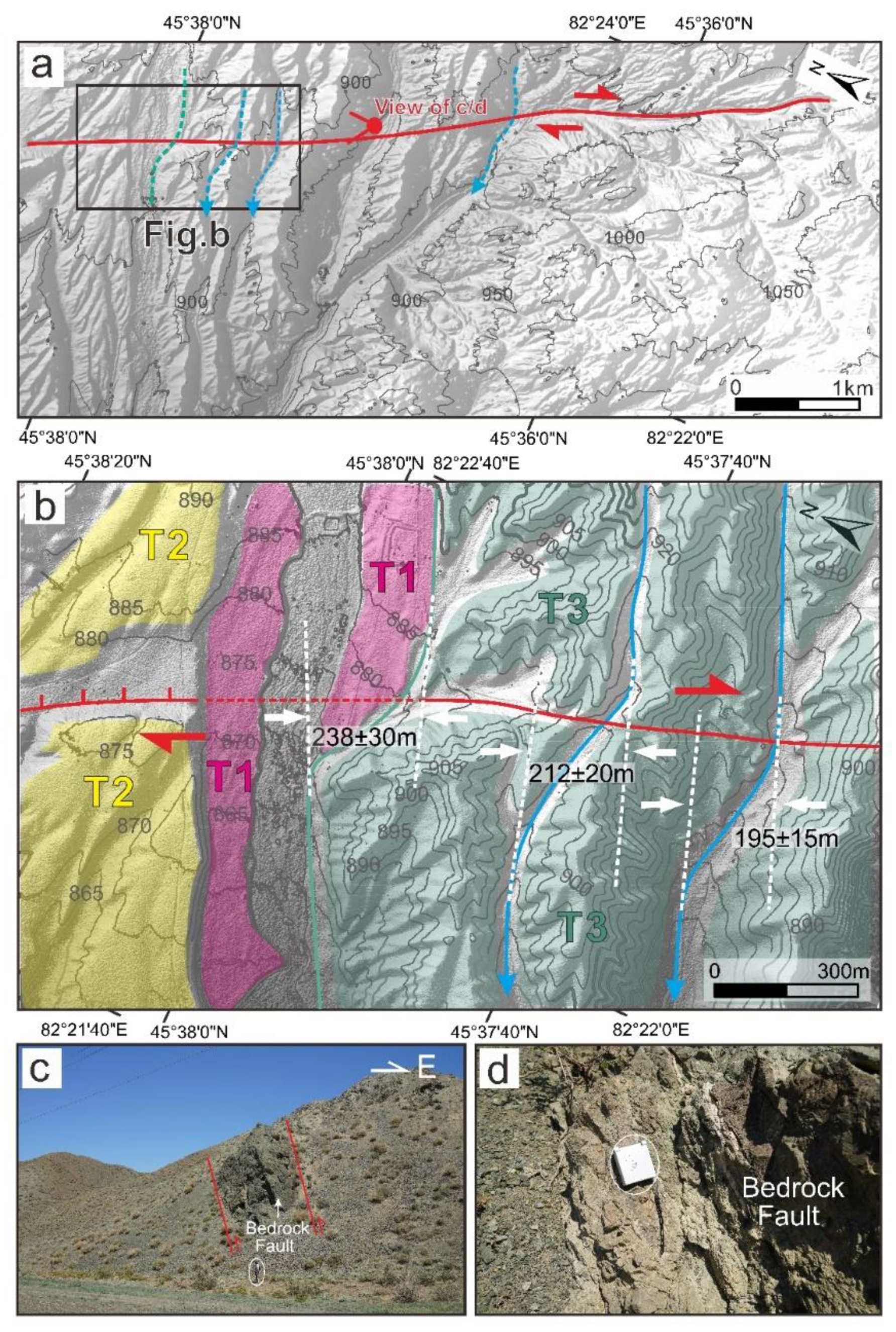
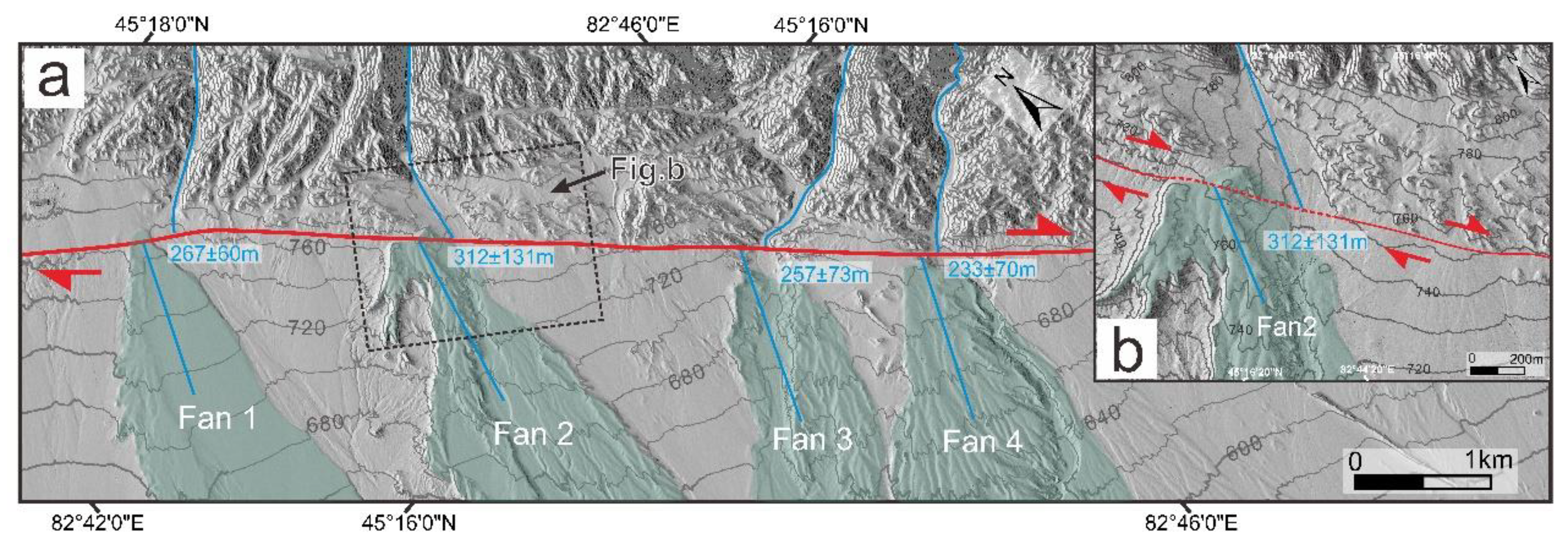
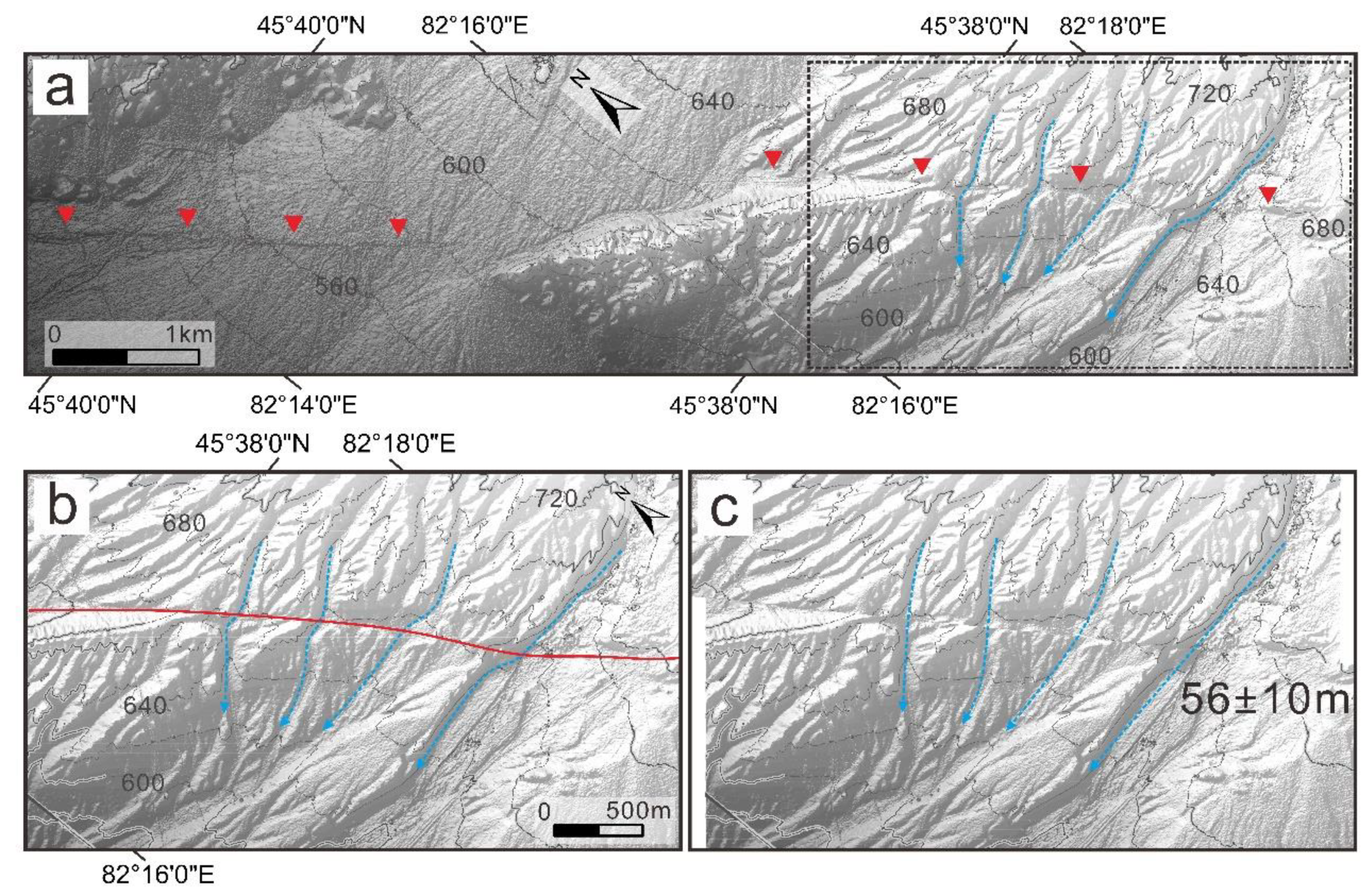
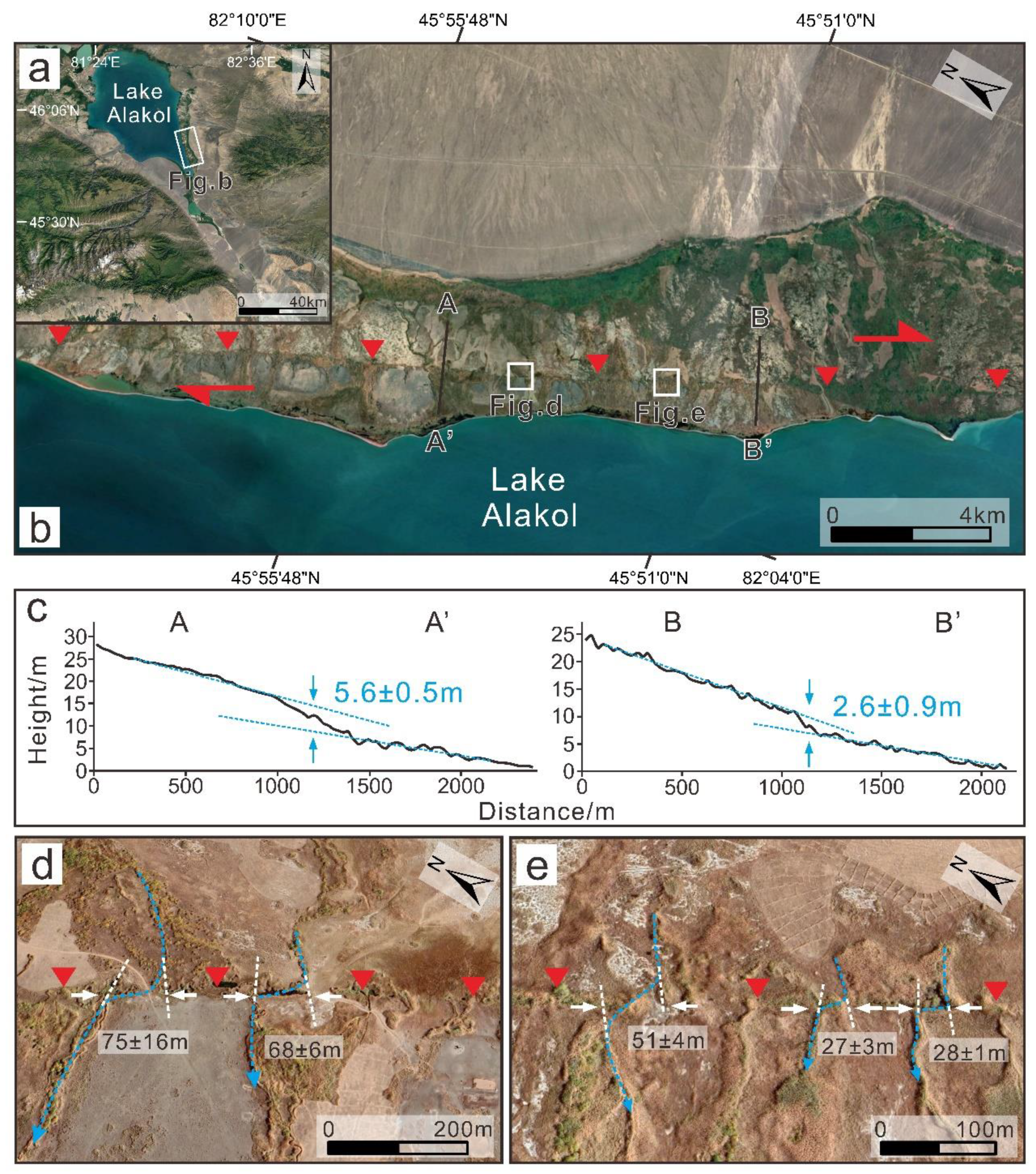
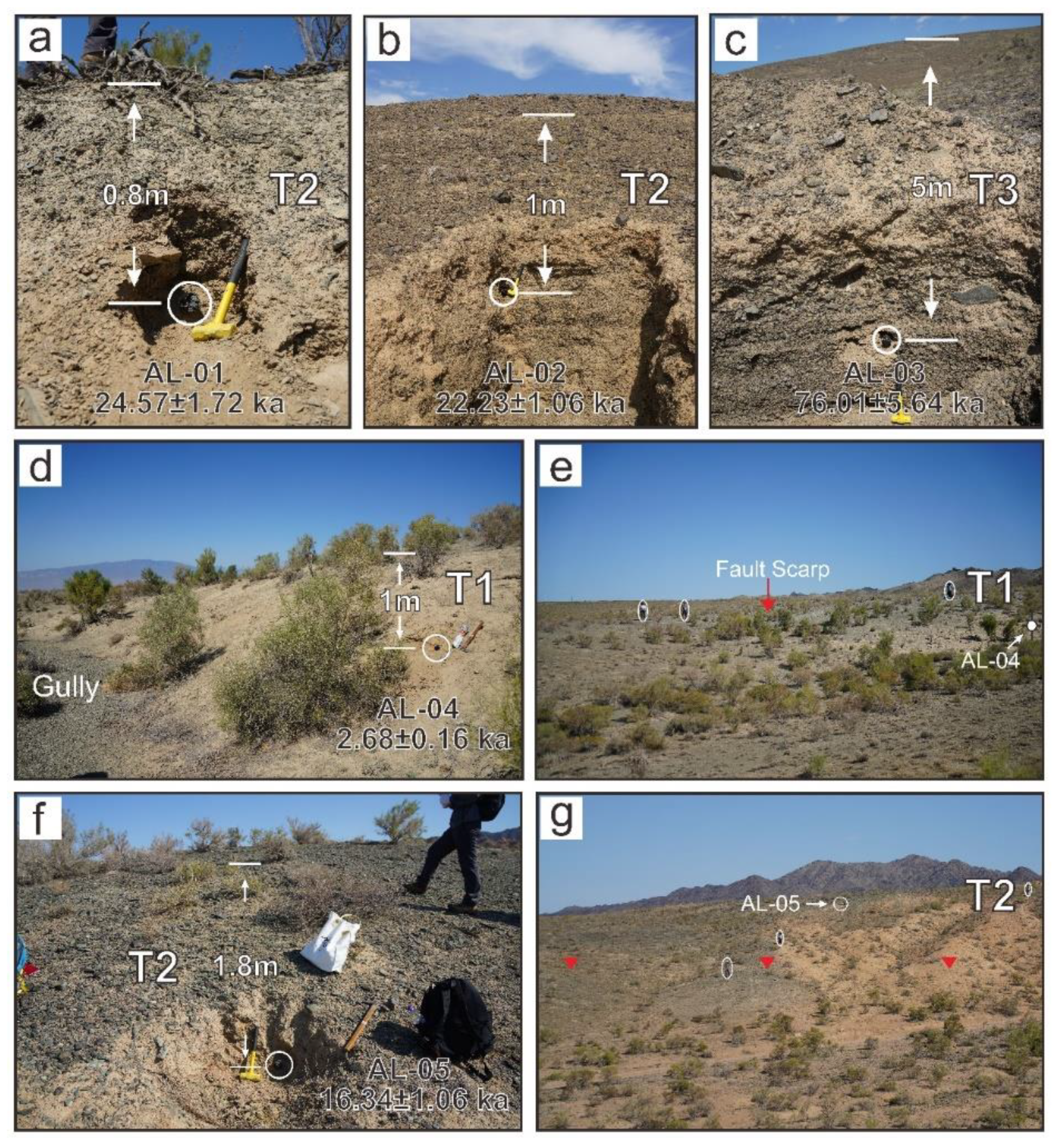
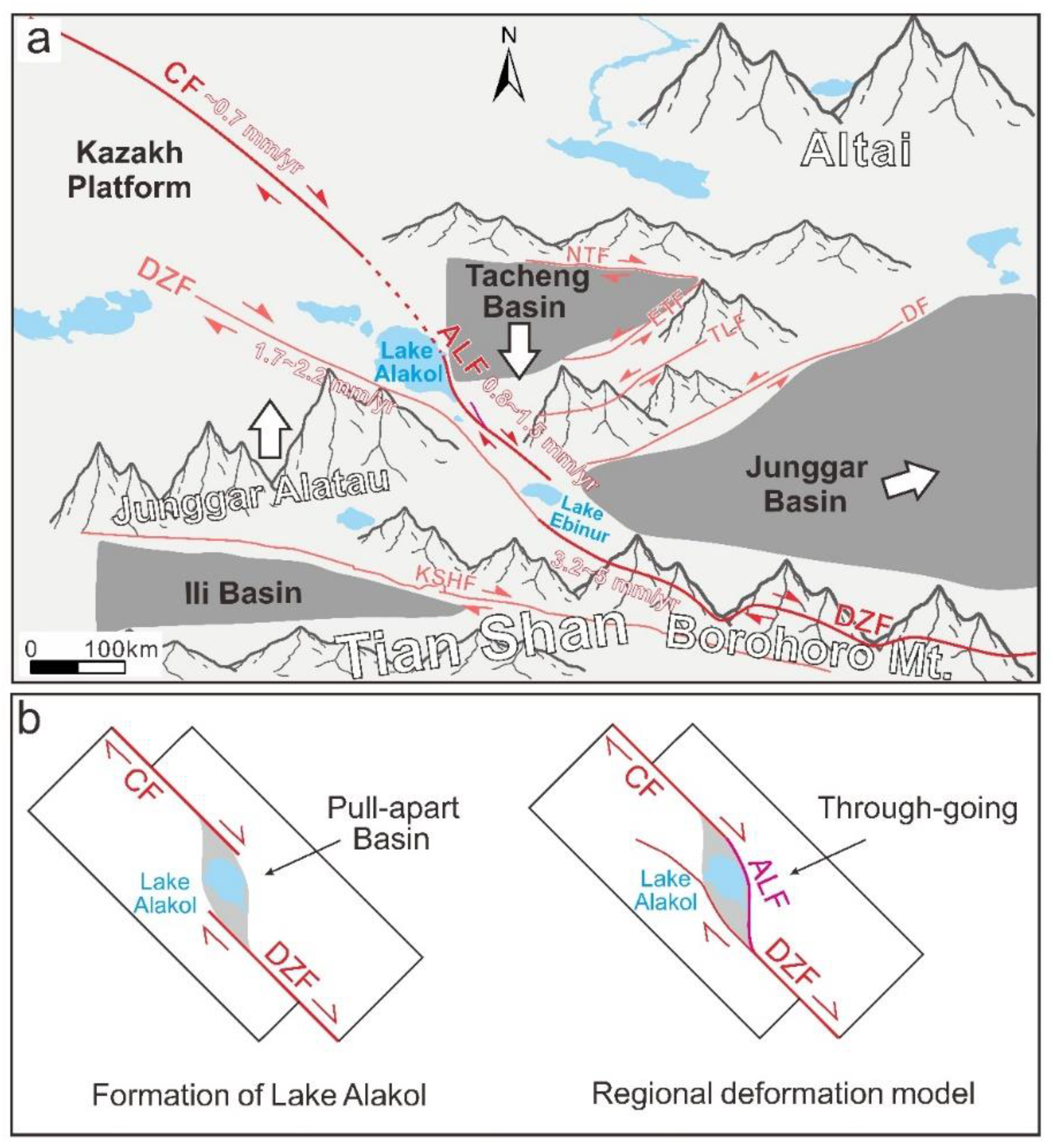
| Sample ID | Sample coordinate | Depth (m) |
U (ppm) |
Th (ppm) |
K (%) |
Water content (%) | D (Gy/ka) |
DeMAM (Gy) |
AgeMAM (ka) |
DeCAM (Gy) |
AgeCAM (ka) |
DeAVG (Gy) |
AgeAVG (ka) |
|---|---|---|---|---|---|---|---|---|---|---|---|---|---|
| AL-01 | 45°21′01″N 82°38′56″E |
0.8 | 2.12±0.01 | 6.57±0.08 | 1.69±0.01 | 5 | 2.73±0.11 | 39.7±3.15 | 14.57±1.3 | 64.24±3.91 | 23.57±1.72 | 66.96±3.81 | 24.57±1.72 |
| AL-02 | 45°32′24″N 82°26′29″E |
1 | 1.55±0.04 | 4.6±0.11 | 1.59±0.01 | 5 | 2.37±0.1 | 49.53±2.59 | 20.88±1.39 | 52.62±1.23 | 22.18±1.05 | 52.74±1.27 | 22.23±1.06 |
| AL-03 | 45°32′25″N 82°26′28″E |
5 | 1.59±0.03 | 4.5±0.05 | 1.35±0.01 | 5 | 2.05±0.09 | 155.45±9.57 | 76.01±5.64 | 196.36±7.61 | 96.02±5.45 | 199.3±7.09 | 97.46±5.32 |
| AL-04 | 45°21′38″N 82°38′21″E |
1 | 1.69±0.03 | 7.28±0.05 | 1.89±0.01 | 3 | 2.94±0.12 | 5.65±0.39 | 1.92±0.16 | 7.7±0.33 | 2.62±0.16 | 7.87±0.35 | 2.68±0.16 |
| AL-05 | 45°19′07″N 82°41′39″E |
1.8 | 2.08±0.04 | 9.45±0.11 | 3.15±0.01 | 5 | 4.26±0.18 | 52.48±4.6 | 12.31±1.2 | 68.43±3.43 | 16.05±1.05 | 69.67±3.43 | 16.34±1.06 |
Disclaimer/Publisher’s Note: The statements, opinions and data contained in all publications are solely those of the individual author(s) and contributor(s) and not of MDPI and/or the editor(s). MDPI and/or the editor(s) disclaim responsibility for any injury to people or property resulting from any ideas, methods, instructions or products referred to in the content. |
© 2024 by the authors. Licensee MDPI, Basel, Switzerland. This article is an open access article distributed under the terms and conditions of the Creative Commons Attribution (CC BY) license (https://creativecommons.org/licenses/by/4.0/).





